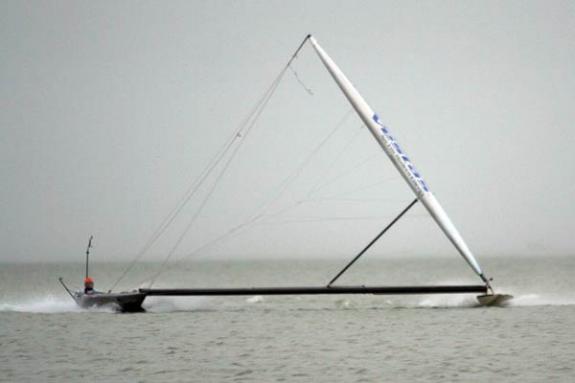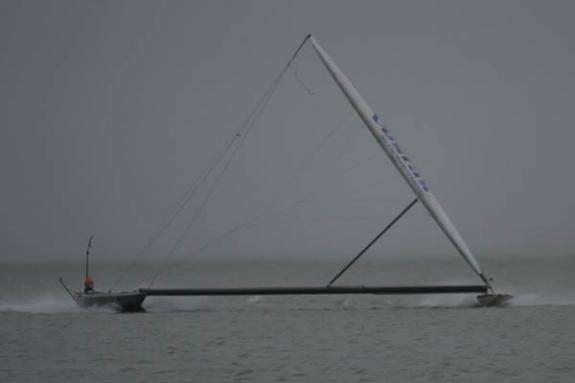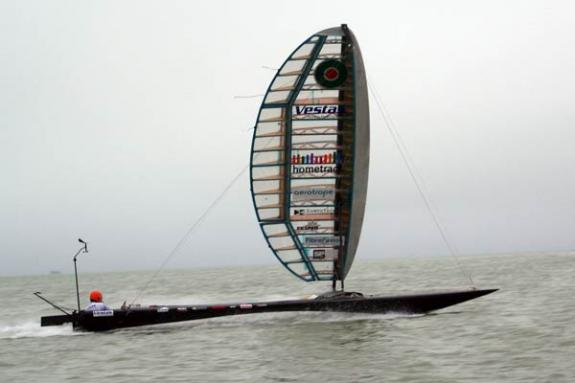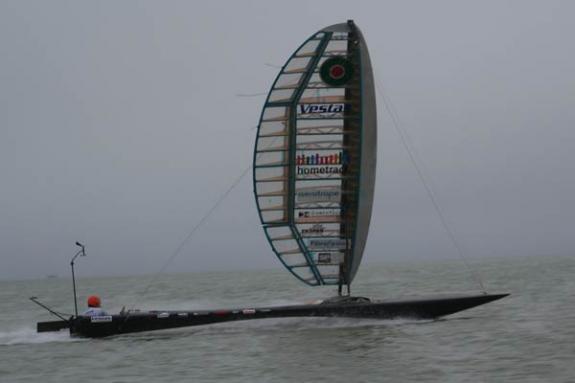Paul's blog
Run 40 flies by, high and dry...
Although it was far from being the fastest... I would have to say that Run 40 was the cleanest run we have ever done on a number of fronts.
It was an extremely grey day which started with very little wind. One of the best 'care' packages you can ever receive in a sailing project arrived in Walvis Bay today in the form of two big boxes of MUSTO clothing! Inside, amongst many other things, were 5 new drysuits and they couldn't have arrived on a bleaker or more suitable day. We were busying ourselves with sorting through this, cutting down neck seals and so on and had all but given up on sailing as 3pm came and went.
The smell of sulphur was strong in the air. I mean real strong. In fact it stank of sulphur... like walking up a volcano. You get this from time to time as algae dies in the lagoon and decomposes on the bottom. The water goes milky and the smell of 'rotten eggs' fills the air. It's usually not quite this offensive.
I walked out of the container and saw that the wind was building. The walls of the container had begun to close in as we hadn't been sailing for a week or so. I leapt at the opportunity to go for a sail. I rang Hiskia and told him to forget the bike and get a cab in ASAP. The sun sets around 5.30pm so we had to jump to it. It was an absolute pleasure to put on the MUSTO gear. The wetsuits they had previously supplied had done a great job... but drysuits bring a whole new level of comfort. It really blew Andreas away when he first walked into the water... and didn't feel the rush of cold and damp. He quickly understood what we had been making a fuss about!
Man it was grey. It was even hard to see the timing hut at times due to fog! I will add the real pictures next to the digitally modified ones just to show you how grey it really was! We set up the course and prepared for run number 40. The wind hadn't built as much as we had expected but it still seemed enough for a run. There were a number of changes from the last run. They were as follows...
- The new carbon spray deflector on the forward planing surface. It's a light but significant structure that needed to be tested. It would be submerged through the start up sequence and lift clear of the water by a couple of inches at speed. It's low speed effects on the craft were yet to be seen.
- The new PI RESEARCH wiring and complete BandG sensor package was now installed so we would have a complete integrated data logging system up and running
- The Gecko VHF headset had broken once again so we have gone back to an ICOM headset for comms. It is an area we continue to struggle with. You would think it would be simple... apparently not.
- The hand steering system had been upgraded to make it much more functional and the large low speed rudder kick up mechanism had also been improved
- The system for sheeting in the main flap on the wing had been re-adjusted so that it would come on in automatically in a nice and progressive way when I pulled the mainsheet into the 10-15 degree range.
So all in all there was plenty of things that needed to be 'speed-spot' tested.
The launch went well but the wind was light. Mr 'M' was reading winds as low as 12-13 knots on the TACKTICK shorebased weather station. I could feel the extra drag of the spray deflector on the start up. It wasn't huge... but it was noticeable. Vestas SailRocket lifted her skirts in a puff and we were away. The water was very flat in the lightish conditions but the reduction in spray was noticeable. In fact it took me a while to remember to lower the visor. I could see a jet of spray from the planing surface out the leeward side... but only flat deflected spray out to windward. I lined up with the 500 meter course and went to hand steering. The wing flap sheeted on nicely with the mainsheet and all the telltales were flying. Every thing was working perfectly so I pulled the rudder trip cord and up popped the large low speed rudder. For the first time we were steering under the skeg flap alone... and it felt lovely. I could see clearly, I was dry, The ICOM VHF was as clear as a bell and the steering was sweet.

A visibly smaller 'jet' of spray to windward due to the muffling effect of the spray deflector. This is a 'brightened' up shot... the following is the actual shot showing the true 'greyness'.

Pretty grey hey? Put a rotten egg under your nose for an extra touch of reality.
I held Vestas SailRocket on course until we passed the last SEAFLEX buoy marking the end of the course and then checked out how well the skeg steering would function during a slow down sequence. It maintained control for all of the necessary manoeuvres. The large low speed rudder came back down nicely and all was back to normal.

Here the rudder is kicked up, we are doing about 32 knots and look how much less spray there is off the back of the boat with it up. She felt light and slippery.

And the grey version again...
So overall it was a very clean run where a number of necessary improvements were trialled. We went through a full sequence of what needs to be done for a record run and everything worked well. Now I am more aware than anyone of how easy it can all look in lightish conditions and how pear shaped it can go in a blow... but, from my perspective in the cockpit... this was a good day that lays a foundation for runs to follow.
The MUSTO gear had us smiling throughout a rather cold old day. In fact the contrast in the modified and the real pictures above could also represent the change in our comfort level.
Happy days.
Today also looks good with even more wind... so let's see if the ease of run 40 will translate.
Cheers, Paul